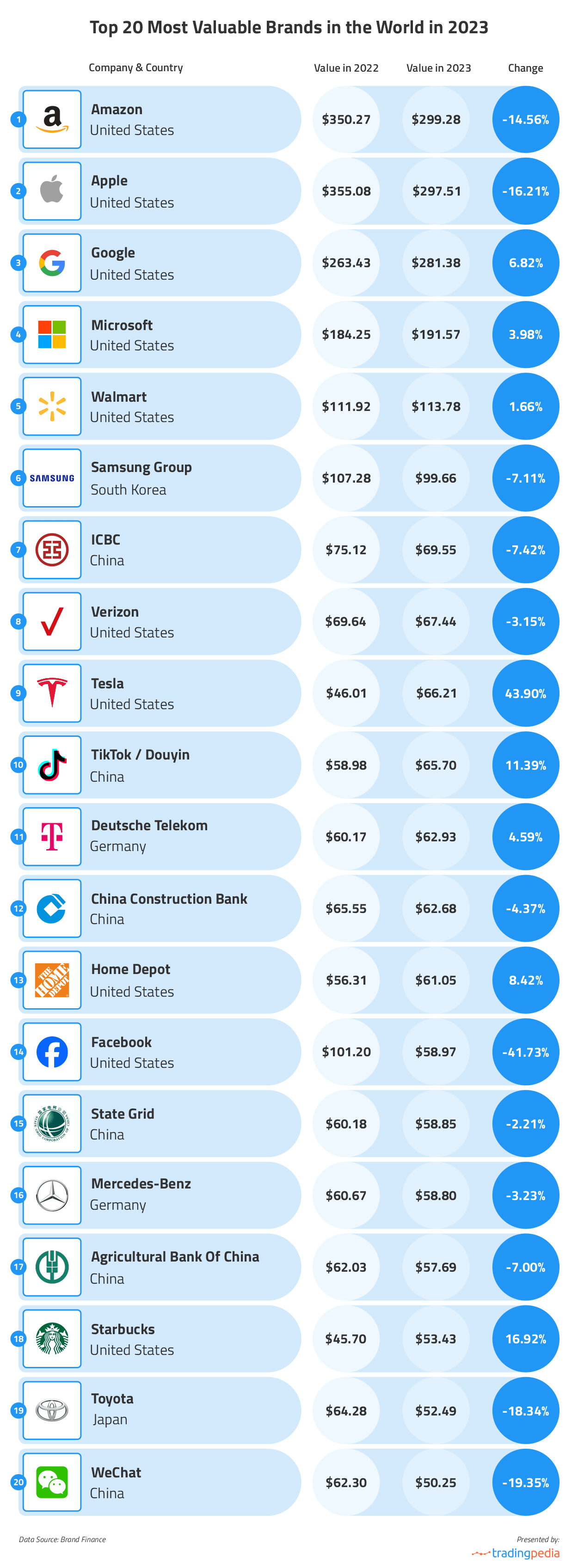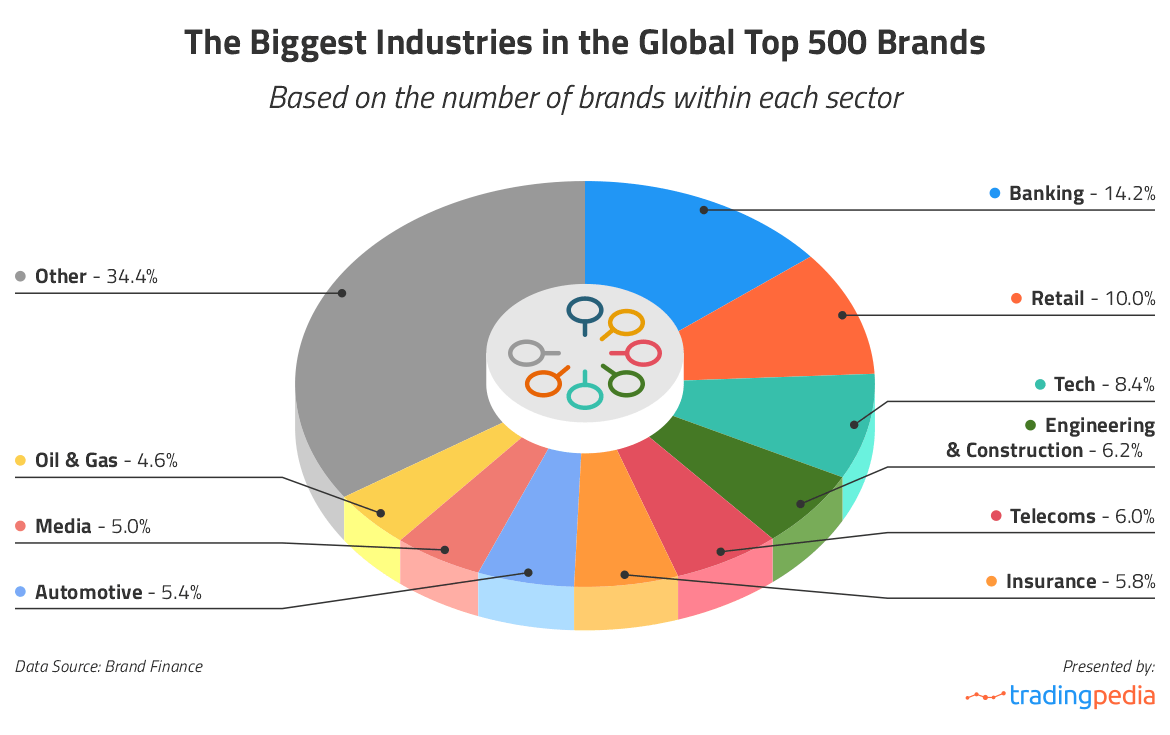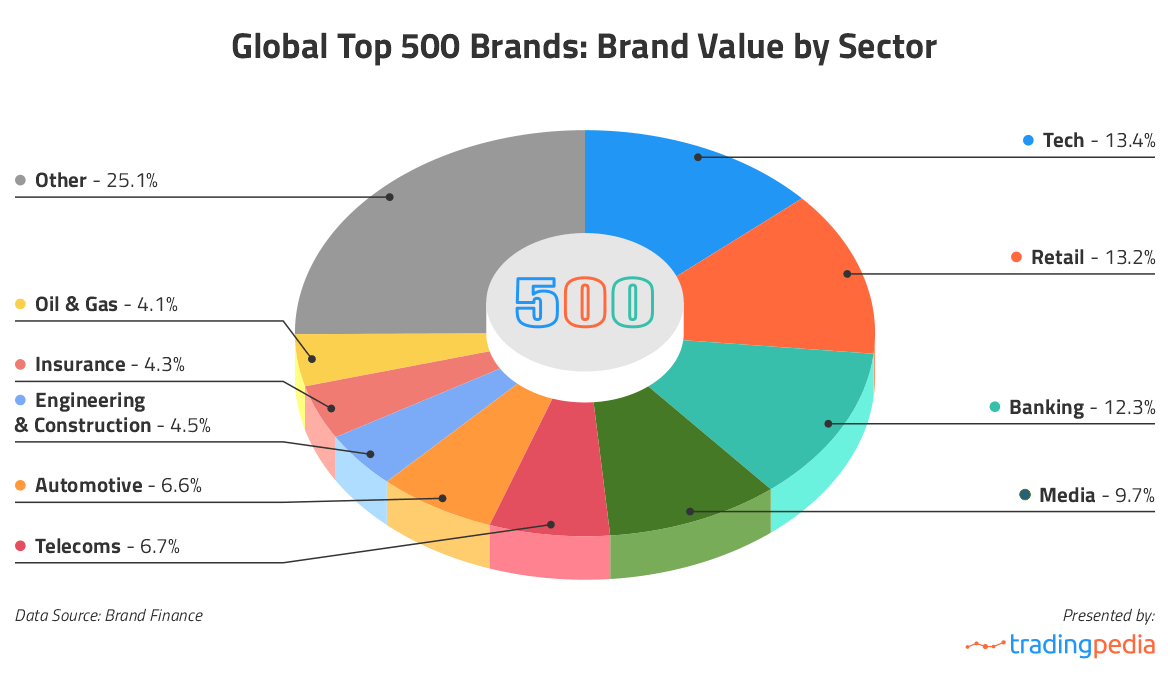The team at TradingPedia decided to take a look at the biggest companies in leading markets, including the United States, China, Germany, and the United Kingdom. We identified the largest brands in a total of 45 countries, in terms of value, and created a map visualising the global top brands in 2023.

Methodology
Several reputable publications, including Forbes and Brand Finance, come up with a brand ranking every year. However, each has its own method of determining the value of a company or brand. Brand Finance, the publication we relied on for this visualisation, calculates the value of a brand in quite an interesting way, using the Royalty Relief method. In essence, researchers at Brand Finance determine the value a company “would be willing to pay to license its brand as if it did not own it”.
We based our research on Brand Finance’s annual report on the top 500 global brands, and also sifted through dozens of country and industry-specific reports published on its Brandirectory website.
We compiled all the data they produced and then trawled through it to find:
- Every country in the top 500
- The top 3 brands for each country in the top 500 (if they have 3)
- Every country in the top 100
- For each country in the top 100 brands list, the total number of brands in the top 100 ranking (if any)
The Biggest Brands Around the World in 2023
The world’s most valuable brand in 2023 started as an online bookstore in the 1990s but grew to be the largest retailer on the Internet. Despite shedding a staggering $51 billion in value since 2022, Amazon is currently the biggest brand in the world with an estimated value of $299.28 billion. It beats last year’s leader Apple, which lost 16% of its value, with a current worth of $297.51 billion. Third on the global ranking is yet another technology giant from the United States, Google, which has increased its value by nearly $18 billion since 2022 to $281.38 billion.
In fact, seven of the top 10 most valuable brands in the world are American, with Microsoft ($191.57 billion) and Walmart ($113.78 billion) coming in fourth and fifth positions respectively. The rest of the top 10 U.S. brands are Verizon (8th place, $67.44 billion in value) and Tesla (9th place, $66.21 billion in value).
The world’s most valuable non-U.S. brand is South Korea’s Samsung Group, which lands in 6th place, with an estimated value of $99.66 billion in 2023. The electronics giant has lost $7.62 billion in value from 2022 but maintained its strong position, and is way ahead of the next biggest brand on the ranking, China’s ICBC. The state-owned commercial bank has a value of $69.54 billion in 2023, down 7% from it’s 2022 value. Tenth on the list is TikTok/Douyin, the Chinese social media company that became the fastest-growing brand last year (215% rise in value). From 18th position in 2022, it moved to the 10th place this year with an estimated value of $65.7 billion.
Germany’s Deutsche Telekom ranks 11th in the world and 1st in Europe in terms of brand value ($62.63 billion), and Japanese car maker Toyota is 19th globally with a value of $52.49 billion. The rest of the top 20 brands are either American, Chinese, or Korean. But which companies have the most valuable brands in the rest of the world?
British oil and gas giant Shell is the largest brand in the UK, with an estimated value of $48.21 billion in 2023, down 3.44% from last year. In the Netherlands, the top spot is held by banking and financial services corporation ING (up 0.97% to $9.71 billion), while in France, the most valuable brand is the fashion giant Louis Vuitton (up 12.23% to 26.29 billion). The largest Swiss brand, on the other hand, is held by the food and drink company Nestle, which has risen 7.72% in value to $22.43 billion in 2023.
In Canada, TD Bank emerges as the top 2023 brand with a value of $20.4 billion (up 16.51% YoY), and another banking giant, Itau, is the most valuable brand in Brazil with a value of $8.72 billion (up 32.02% YoY). The largest brand in Australia is Woolworths, a retail and financial services operator, which is also the largest company in the country in terms of revenue and number of employees. The brand has increased in value by 7.08% from last year to $10.89 billion in 2023.
How Many Countries Have Brands in the Top 500 Brands List?
One thing we noticed is that there aren’t many countries that actually produce big brands. Only 30 countries have brands in the global top 500 list and nearly half of them (14) are European. That’s out of a total of 195 countries that exist. The nations represented in North America are the United States, Canada, and Mexico; South America is represented by Brazil, in North; The Middle East has Saudi Arabia, Qatar, and the United Arab Emirates; Asia is represented by South Korea, China, Japan, India, Malaysia, Singapore, Vietnam, and Thailand, and Oceania by Australia.
There are 14 European countries in the top 500 brands list: Germany, the United Kingdom, France, Italy, Spain, Sweden, Norway, Russia, Switzerland, the Netherlands, Finland, Denmark, Austria, and Belgium. However, there are unfortunately no African countries with a brand in the top 500.
Another interesting discovery we made is that there are very few countries that seem to be able to produce big brands in any kind of volume. In fact, there are only 20 countries with more than 3 brands in the top 500. These are the United States, South Korea, China, Germany, Japan, and the United Kingdom, Saudi Arabia, India, France, Canada, Italy, Spain, Sweden, Russia, the UAE, Australia, Switzerland, Singapore, Brazil, and the Netherlands.
A High Concentration of Major Brands in a Handful of Countries
When you look at the 500 or 100 most valuable brands in the world and where they are located, you find there is a large concentration of major brands in relatively few countries. There is a particularly high concentration in China and the United States, with 202 of the top 500 brands in the U.S., and 79 in China. When we look at the 100 biggest brands, more than half (53 to be exact) are American and 22 are Chinese.

Just for reference, Germany has 7 brands in the top 100 list, followed by Japan with 6, South Korea with 4, and the United Kingdom with 3. The U.S.’s brand dominance can be seen in the top 20 list as well, where ten of the brands are American, while six are Chinese. Interestingly, most of the companies in the top 20 list have shrunk in value since 2022, according to the data. Facebook has lost the most value over the past year, down from $101.2 billion in 2022, to $58.97 billion in 2023. In other words, it lost 42.23 billion (41.73%) in value in just a year.
Tesla, on the other hand, is one of the fastest-growing brands in the world, seeing a rise of 43.9% from last year to its current value of $66.21 billion. Starbucks are TikTok are also on the rise. The American coffeehouse chain has seen a 16.92% growth in value to $53.43 billion, and the Chinese social media platform has increased in value by 11.39% to $65.7 billion.
The Biggest Industries
In case you’re wondering which industries do the best in global rankings, here are the figures on the percentage share the biggest industries have of the top 500 brands list.

Clearly, the banking industry dominates the world of top global brands if we consider the number of brands in each sector. Roughly 14.2% of all brands in the top 500 are banking and financial services companies, while 10% are in retail. Technology, engineering and construction, and telecoms, are all huge industries as well. However, in terms of value, technology and retail are on top, with tech brands responsible for around 13.4% of the total value of the top 500 companies, and retail brands for bringing in 13.2%.

Final Thoughts
It would seem that not every country can birth a big brand, with larger economies having the upper hand. However, brands still come from all over the world, and sometimes, against all odds, smaller economies produce some of the world’s most recognisable brands. Two great examples of this are Finland with its Nokia phones, and Mexico with Corona beer.
Source: Tradingpedia





